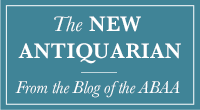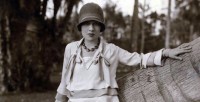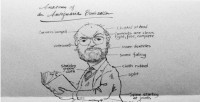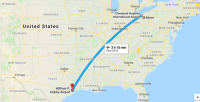Pioneering screenwriter Anita Loos was born on April 26, 1889. After learning her trade acting and writing one-act plays for her father's somewhat-disreputable theater troupe, Loos began submitting unsolicited scripts to film companies. D.W. Griffith directed The New York Hat, a film based on her screenplay, starring Mary Pickford and Lionel Barrymore in 1912. In 1915 Loos became the first “staff writer” for a film production company, when she signed on with Griffith's studio. She wrote hundreds of scripts during the silent era of cinema, most of which went unproduced, but the films that were made were noted for their wit and humor — all the more remarkable for being silent! Her collaboration with director (and future husband John Emerson) began by working on several romantic comedies which made Douglas Fairbanks a star. In later years, many of the scripts that carried both of their names would be primarily Loos' work, however. It was often convenient, in the Hollywood system of the 1930s and '40s, to have a male co-writer, as some directors were unwilling or uncomfortable discussing the script with a woman. During a period of infatuation with H.L. Mencken (who apparantly had a thing for blondes) Loos wrote a series of stories about a chorus girl on the lookout for a rich paramour, the Lorelei Lee stories. These were such a hit for Harper's Bazaar that they soon became a novel, Gentlemen Prefer Blondes (1925) which became a runaway bestseller. A broadway adaptation foll... [more Anita Loos: Hollywood Pioneer]
ABAA-member Kenneth Karmiole has endowed a new research fellowship at his alma mater, the University of California Santa Barbara. This is the second endowment Karmiole has established at UCSB, the first supports the purchase of rare books. Karmiole says that university libraries are becoming increasingly valuable resources, because “Old bookstores are closing left and right, so universities are the great repositories of printed history." A press release from UCSB details how the UCSB library was an important part of setting Karmiole on his career path: As a history major at UCSB in the 1960s, Kenneth Karmiole liked to hang out in used bookstores. He often found scholarly books from the 19th century that sold for $1, and wondered why they weren't worth more. To learn about the academic book business, he sought out UCSB Library's head of collections for advice, and ended up spending a lot of time at the Library. Back then, his first big find as a book trader, Karmiole said, was a stash of scholarly books on Peru purchased at a Santa Barbara garage sale. He bought the entire collection — plus the bookcases they were shelved on — for $16. Alan Grosenheider, Acting University Librarian, said the new fellowship will “provide opportunities for scholars to use our Special Research Collections from a fresh perspective and share their discoveries with the campus community, sparking different approaches or opening new intellectual terrain to explore. I have deep appreciation for... [more Kenneth Karmiole Endows Research Fellowship]
UPDATE: This item has been recovered. The following item has gone missing in transit: (COOKERY). MIDDLETON, JOHN. FIVE HUNDRED NEW RECEIPTS IN COOKERY, CONFECTIONARY, PASTRY, PRESERVING, CONSERVING, PICKLING; AND THE SEVERAL BRANCHES OF THESE ARTS NECESSARY TO BE KNOWN BY ALL GOOD HOUSEWIVES.(London: Printed for Thomas Astley, 1734) 206 x 124 mm. (8 1/8 x 4 7/8"). 1 p.l. (title), iv, 249, pp. Revised and recommended by Mr. Henry Howard. FIRST EDITION. Pleasing recent retrospective chestnut-colored calf, covers with central frame formed by multiple blind and decorative rules, fleuron cornerpieces, raised bands, maroon morocco label. Printer's woodcut rose device on title page. Bitting, p. 324; Oxford, p. 64; Vicaire, col. 598; Maclean, p. 101. Title page a little soiled, very faint dampstain to tail margin of first half of text, occasional minor marginal stains, smudges, or corner creases, other trivial imperfections, but AN EXCELLENT COPY of a book difficult to find in pleasing condition, the text generally clean and fresh with especially ample margins, and in an unworn sympathetic binding. If you have any information on this item, please contact Phil Pirages Fine Books and Manuscripts at 800-962-6666 or jill@pirages.com. [more Missing in Transit]
A selection of rare books and print ephemera newly listed or catalogued by members of the ABAA. The Island of Doctor Moreau by H.G. Wells London: William Heinemann, 1896. Pictorial ochre cloth, stamped in black and red. Frontis. Rear inner hinge cracked (but sound), some rubbing to cloth and small offset spots to lower cover, some shallow splashmarks along the top edge of the front free endsheet and pastedown, a bit of foxing to the tissue-guard, otherwise a very good copy. First UK edition, in the preferred state of the binding, with the blindstamped logo in the lower corner of the lower cover. The terminal catalogue is the 32pp. form beginning with THE MANXMAN and concluding with OUT OF DUE SEASON. Among Wells's most important works, functioning as both an imaginative entertainment, and as a cautionary tale about scientific progress unconstrained by ethics. The sourcework for three film adaptations of varying degrees of success. Offered by William Reese Company. Preliminary Cover Design for Penny Candy, by Edward Fenton Gorey, Edward (illus.) c. 1970. Watercolor and ink on paper, measuring 8 1/4 by 7 1/4 inches. Archivally matted and framed. Preliminary artwork for the cover design of Fenton's book, a fantasy story based on the English “Tinker Tailor” rhyme. A copy of the trade paperback edition of the book, which was published by Holt in 1970, is included in a sleeve affixed to the back of the frame. The key differences between this preliminary drawing and the finished... [more Books of the Week]
Why is it that we love tales of book heists? Two new films set in the world of rare books, both crime thrillers, are coming in 2018. The first trailer for "Can You Ever Forgive Me?", based on Lee Israel's career as a forger of literary letters was released this week, and the trailer for "American Animals" based on a 2004 robbery of the Special Collections Library of Transylvania University, in Lexington, Kentucky has been playing for a short time. The proximity of these two films may simply be coincidence, but the source material for these tales -- magazine articles about book thieves and true-crime accounts of heists succesful and unsuccessful -- are abundant. Perhaps it's simply an extension of the idea that everyone has a book in them -- which makes so many people think they could be an author "if they had the time" -- that draws people to these stories? Or, perhaps it's the popular "cash in the attic" idea that makes people think they might already possess some valuable books, and they can relate better to stories about book thefts than to thefts of say, gold bullion, plutonium, or casino profits? Articles declaring that rare books are the hot collector's item of the moment, or claiming that certain categories of books are somehow recession proof, do nothing to disabuse people of this notion. (For the record, the ABAA cautions against viewing rare books as financial investments, and encourages collectors to focus instead on their interests.) It's not news to book collecto... [more Hollywood Loves Rare Books]
Our monthly roundup of the stories bibliophiles are reading, sharing, and discussing. Kenneth Karmiole Establishes Research Fellowship at UCSB ABAA_member Kenneth Karmiole has established the Kenneth Karmiole Endowed Research Fellowship, which will support scholars working with primary resource materials and rare books in the University of California Santa Barbara Library. How a rare Revolutionary War-era document ended up in Utah “Who knows what's in anybody's garage, right?” Read more... 2018 Pulitzer Prizes Andrew Sean Greer won the 2018 Pulitzer Prize for Fiction for his novel Less; Caroline Fraser won the Biography Price for her biography of Laura Ingalls WIlder, Prairie Fires: The American Dreams of Laura Ingalls Wilder; and Frank Bidart won the Pulitzer Prize for Poetry for his volume of Collected Poems, Half-light. Read about all the winners here... Police Recover "Potentially Stolen" Rare Books Here's a minor literary mystery that some book collectors might be able to help the Welsh police with. During a separate investigation, police found an old suitcase containing some "potentially rare" Victorian books and jewelry. The books, including a Bible and a copy of Alice's Adventures in Wonderland, were dedicated to a "Mary Elizabeth Taylor" and carried dates between 1892 and 1894. Anyone with any insight into the rightful owner should contact North Wales Police. Bromer Booksellers Temporarily Relocates If you are book-hunting in Boston, be advised that ABAA-member B... [more Rare Book News]
ABAA-member Raymond Smith has an exhibition of his black-and-white photography, "In Time We Shall Know Ourselves" running at the Bruce Museum in Greenwich, CT through June 3, 2018. Inspired by the photographs taken in the American South in the 1930s by Walker Evans, a teacher and mentor of Smith at Yale University, as well as by Robert Frank's The Americans (1958), in the summer of 1974 Smith embarked on a photographic expedition of his own. Smith traveled with his Australian friend Suzanne Boyd in an aging Volkswagen from New England through the South and into the Midwest, photographing the people and places he encountered during the three-month journey. Lecture/Reception The Bruce Museum will host a reception and artist talk for the exhibition on Sunday, April 15, 3–5 pm. At 3:30 pm, Raymond Smith will present a lecture titled, “I Am a Camera,” which will be followed by a Q&A and book signing. The reception is free for Bruce Museum members and students (with valid ID); tickets for non-members are $15. Advance registration is required, as seating is limited. For more information, vist brucemuseum.org... Raymond Smith. Farm Worker's Family, Dillon, South Carolina. 1974. Smith collected some of these photographs into the book In Time We Shall Know Ourselves (which features perceptive essays on Smith's photography by Alexander Nemerov, Professor of Art History at Stanford University, and Richard H. King, Professor Emeritus American Intellectual History at the University o... [more In Time We Shall Know Ourselves]
Meet the latest members of the ABAA. Andrea Peacock, Elk River Books Andrea Peacock is an author and former newspaper journalist who took up bookselling when she and her husband built a new house and didn't have enough room for all their books. She teamed up with Marc Beaudin and in 2011 launched Elk River Books, an open shop in the small town of Livingston, Montana, which sits along the big bend of the Yellowstone River. After a few years, she tired of selling $7 paperbacks to tourists, and attended CABS on a friend's recommendation. That changed everything. They moved from their tiny storefront into an enormous building in Livingston's arts district, and refocused on antiquarian and collectible books. She took classes at Rare Book School, and began specializing in works by the Montana Gang and “outdoor literature”—a catchall that includes adventure, Western and Native American history, hunting and fishing, natural history and anything else fun that comes in the door. Marc Beaudin, Elk River Books Marc Beaudin is a poet, publisher, and theatre artist living in Livingston, Montana -- dubbed “America's finest open-air asylum” for multiple reasons. In 2011, he added “bookseller” to his stack of hats with the founding of Elk River Books with co-owner and cousin Andrea Peacock. He specializes in outdoor literature, Montana authors, poetry, and work by and about James Joyce. His latest book, a travel memoir called Vagabond Song: Neo-Haibun from the Peregrine Journals... [more New ABAA Members]
A selection of rare books and print ephemera newly listed or catalogued by members of the ABAA. Micky Maus: Die Größte Jugendzeitschrift Der Welt (First Edition/First Printing) Schweiz, Österreich, et al. Very Good+. 1969. First Edition; First Printing. Hardcover. First edition/first printing Micky Maus magazines in overall very good+ condition. The seven issues each have some light soiling. Heft 15 has slightly looser binding and some foxing to the covers and Heft 8 has some edgewear including a tear that can be seen on the outer corner of the pages. Otherwise lovely collectibles; Issues of Micky Maus magazines from 1969 including the titles Heft 3: 18. Januar; Heft 8: 22. Februar; Heft 10: 8. März; Heft 11: 15. März; Heft 12: 22. März; Heft 13: 20. März; and Heft 15: 12. April. (Offered by Books Tell You Why, Inc.) The Blind Men and the Elephant By John Godfrey Saxe (Book design and binding by Carol Schwartzott) Niagara Falls, N.Y.: Lilliput Press, . Offset edition of 500. Letterpress edition of 100. Offset Edition: 2.8 x 2.8" accordion-fold flutter book. Printed offset with hand-colored illustrations. Bound in paper wraps with elephant illustration on front cover. In matching paper slipcase with paper title label on spine and elephant illustration on cover. Book design and binding by Carol Schwartzott. Signed and numbered by the artist. Letterpress edition: 1.5 x 1.5" accordion-fold flutter book. Bound cloth with patterned end-papers. Card slipcase with image of ele... [more Books of the Week]
I've been a full-time antiquarian bookseller for over two years now, specializing in selling original materials that tell interesting American stories, with an emphasis on social movements. So my every day involves intellectual adventure as I make a living helping to preserve bits of history. Until the first week of January though, I hadn't quite experienced anything like I'm about to share, so with all due respect to Mr. Everitt, I couldn't think of a better title. I hope you'll keep reading and agree. It started the morning of Christmas Eve a couple weeks ago, when an eBay seller listed several books by the important civil rights activist, W.E.B. Du Bois. Du Bois was a prolific writer, and his books are not uncommon. But, what made these special was they had their dust jackets -- which I knew were rarely seen for these particular titles. The seller also listed a few other scarce African-American pieces, so I sent an email asking if there was anything else. 90% of the time I send an email like that the answer is "no." The other 10% will occasionally involve interesting pieces. I was having dinner at a restaurant with my family later that evening when I heard back from the seller, and his response almost caused me to choke. The seller had bought a storage unit that included the contents of several generations of a black family from Ohio, where at least two women attended Wilberforce University (the first black-owned-and-run university in the United States) and one of the men ... [more Adventures of an Absent-Minded Treasure Hunter]










